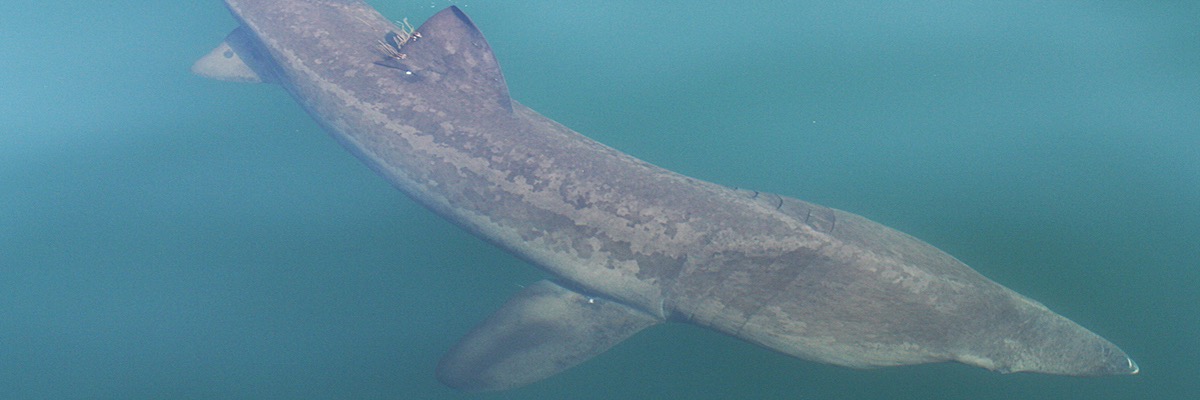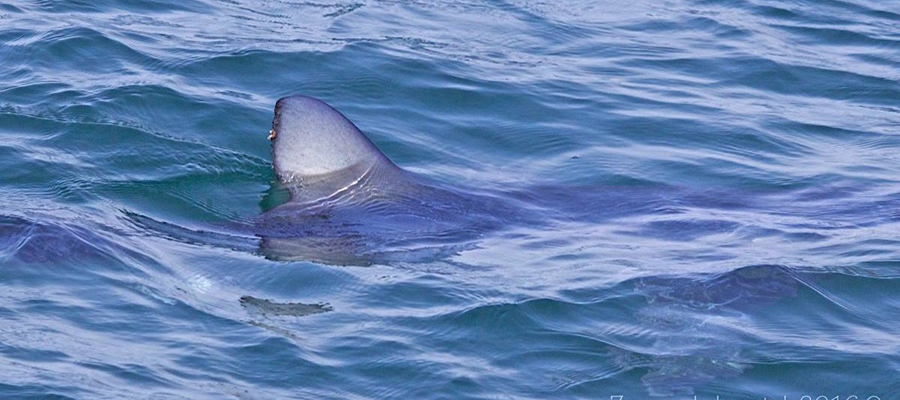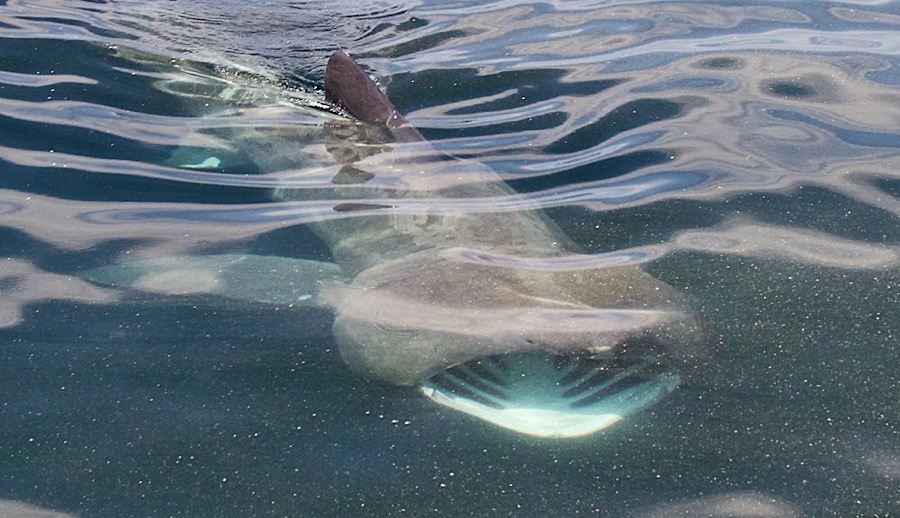Sharks & Other Marine Fish
There are many species of sharks that frequent the waters of the Gulf of Maine. We often encounter sharks while looking for whales and they are always a huge hit (especially with the kids). On this page, you can find a bit of information about some of the more commonly seen species.
BASKING SHARK
Basking sharks are frequent visitors to our area from the late Spring through the Fall, and they are seen on many of our whale watching trips. They received their name because they are often seen swimming lazily along at the surface and seem to be “basking” in the sun (although they are actually feeding).
They are the second largest fish in the world (second in size only to the Whale shark) and some Basking sharks can be as large as some of the whales we see! The largest Basking shark on record was a female accidentally caught in a fishing net in the Bay of Fundy that was a whopping 40 feet, 3 inches long and weighed 38,000 pounds! The typical adult Basking shark, however, is not quite that big. The “baskers” we see are normally 20-25 feet long and about 5 tons or about 10,000 pounds… that’s still a pretty big shark!
Despite their large size and somewhat menacing appearance, Basking sharks are actually quite harmless. The do have teeth, thousands of them in fact, but they are very small and feel more like sand paper to the touch. Actually, Basking sharks don’t even use their teeth when feeding. This is because Basking Sharks are “filter feeders” like the Whale shark and Megamouth shark. When feeding a Basking shark swims slowly along with its mouth open letting water flow in through the mouth and out through the gills. As the water passes over the gills any zooplankton (ie fish eggs, crab or lobster larvae, copepods, etc) that are present in the water get caught on specially designed “gill rakers” which are long, cartilaginous structures (kind of like the teeth of a comb) that protrude from the shark’s gills. Using this feeding method Basking sharks are able to filter up to 2,000 tons of water per hour and can consume over 1,000 pounds of plankton a day!
BLUE SHARK
The second most commonly sighted shark species on our whale watches is the Blue shark. Blue sharks are beautiful animals that frequent cooler waters than most other shark species. They have slender bodies that are silvery-white on the underside, sky blue over most of the back, and a deep indigo blue on the very top of their back and on their dorsal fin. They also have very long pectoral fins that, along with the bluish coloration and slender body shape, make this species pretty easy to identify at sea. Blue sharks can reach lengths of up to 12 feet and can weigh up to 400 pounds (although lengths of 6-9 feet and 120 pounds are more common).
Like the Basking sharks, females are larger and heavier than the males. The Blue shark is a member of a group of sharks known as the “requiem sharks” and, as that name implies, they are voracious predators. They feed on a wide variety of fish and squid species as well as lobsters, crabs, even shrimp. They catch their prey by using their fast speed and sharp teeth to cut swiftly through schools of fish and then they circle back to pick up the dead, dying, or wounded fish. Blue sharks will also attack seabirds sitting on the ocean surface, and will sometimes scavenge for food as well (we have seen them tearing chunks of flesh from the floating carcasses of dead whales).
SHORT-FINNED MAKO SHARK
Another fast and agile shark species found in our area on occasion is the Short-finned mako. While not nearly as common as the Basking or Blue sharks, we have had a number of sightings of makos in recent years. One particular whale watch comes to mind: It was in July of 2012 and we were heading up north to Jeffrey’s Ledge where we had received reports of a few whales from some of the local fishermen in that area. While crossing over the southern part of the ledge we saw a mako leap completely clear from water four times in a row! These sharks are very athletic can reach burst speeds of over 70 mph making them the fastest shark in the world.
Makos can also swim at sustained speeds of over 30 mph for hours on end. One Mako shark was tracked by satellite tag as it traveled close to 2,000 miles in a little over a month. Short-finned makos normally reach lengths of 10 feet and weigh around 300 pounds, with females averaging larger than males. They are superficially similar to Blue sharks in that they are sleek animals and are often a deep blue color on the back and silvery-white on the underside. Close examination, however, reveals many differences between the two species. Makos are more robust that Blue sharks, with proportionally much shorter pectoral fins.
Like their cousins the Great white sharks, Short-finned makos are warm-water animals preferring waters of 60 degrees F or more. Therefore you would expect any sightings of this species to be later in the Summer or early Fall when the water in our area is at its warmest.
GREAT WHITE SHARK
A rare but increasing visitor to our area is the most famous of all sharks: The Great White.
Over the past few years this species has dramatically increased in number off the Massachusetts coast in Summer. The exact reason for this sudden increase is unclear, however, it is likely due to a combination of factors including warming ocean temperatures (Great whites are warm water animals) and an increase in the Gray seal population. Seals are one of the Great white’s main prey items and so an increase in seals would likely contribute to a corresponding increase in Great whites.
The largest Great white sharks can reach 20 feet in length and weigh over 5,000lbs. As with the other species on this page, females are considerable larger and heavier than males.
OCEAN SUNFISH
One of the oddest looking fish you may encounter during one of our whale watching trips is the Ocean sunfish or “Mola mola” (which is actually their latin name). Ocean sunfish are the largest bony fish in the world (some shark species are larger but have skeletons made of cartilage, not bone) and can be 10.5 feet long and weigh over 5,000 pounds. The typical Ocean sunfish, however, is usually around 6 feet long and weighs about 1,000 pounds.
What makes Ocean sunfish so strange looking is that they don’t have the typical fish shape… at least not as adults. When Ocean sunfish first hatch the “fry” are shaped like a typical fish, infact the Ocean sunfish fry look a lot like miniature Puffer Fish to which they are closely related. As they mature, however, the tail fin disappears and the dorsal and anal fins merge to create one large, lobed structure called the “clavus.” This gives the Ocean sunfish the appearance of being a fish which has been cut in half. The lack of a true tail means that they are not the quickest or most agile swimmers, and many individuals show scars from having hit by boats or having a bite taken out of them by a shark of some kind.
Ocean sunfish get their name because they are frequently seen swimming on their sides at the surface on hot Summer days and appear to be sunning themselves. They are actually feeding, however, and their diet is made up almost exclusively of jellyfish. Their pectoral or side fins can often be seen sticking up out of the water and can look a lot like the dorsal fin of a shark.
Ocean sunfish prefer warmer waters of 50 degrees F or greater and thus we usually don’t start seeing them until the end of the Spring when the water has had a chance to warm up a bit.
ATLANTIC BLUEFIN TUNA
Atlantic bluefin tuna (Thunnus thynnus) are found in our area from July through October. Schools of hundreds, even thousands, are sometimes seen breaking the surface and the splashing they create can fool even an experienced whale watcher into thinking they’ve just spotted a pod of dolphins! These large schools of Bluefins usually consist of smaller, juvenile fish that are sometimes referred to as “footballs” because of their small size and football-like shape.
Adult Bluefin tuna can grow to enormous sizes, reaching lengths of over 10 feet and exceeding 1,400 pounds in weight.
Bluefin tuna are a prized game fish and a valuable commercial species. The record price for a single Bluefin tuna was $1.8 million for a 489-pound fish sold at a Tokyo market in the winter of 2013.
Conservation of the Bluefin tuna (both the Atlantic and Pacific populations) is a complicated and contentious issue that is, quite frankly, beyond the scope this webpage. I do invite you to do some research on your own, however, as I feel that this is an important issue that will act as “canary in the coal mine” for how we value and manage natural resources in the sea and, more importantly, how willing and able we are as a species to work across cultural, political, economic, and geographic boundaries to practice sound conservation of wild animals and ecosystems. What I will say is this: Until the people fishing for Atlantic bluefin tuna in the eastern Atlantic and the Mediterranean begin to fish in a more responsible way (for example the way fishermen here in the western Atlantic do with strict quotas and minimum size limits) the future of this species is bleak.
AMERICAN SAND LANCE
A very important species to the marine ecosystem of Stellwagen Bank National Marine Sanctuary is the American sand lance. There are lots of important species (all species are important actually) but I wanted to mention the American sand lance in particular because they are the favorite prey of many of our whales… especially the Humpback whale. Whenever we see Sand lance in abundance, there will surely be alot whales too! Sand Lance (which are often times referred to as “Sand eels” although the are not eels at all) are pencil-sized, pencil-shaped fish that get their because they have a habit of burrowing themselves into the sand on the ocean floor to evade predators or to rest safely out of site from the long list of animals that like to eat them. Their sharply pointed snouts allow them to burrow into the sand so quickly they can seem to just disappear into the bottom almost instantaneously. They can breathe even when completely buried because the sandy bottom of Stellwagen Bank is aerated by the strong currents that flow through the area. Stellwagen Bank’s unique geology is ideal Sand lance habitat and so Stellwagen Bank and its sandy substrate is largely responsible for making Massachusetts Bay the premier whale watching destination that it is.





